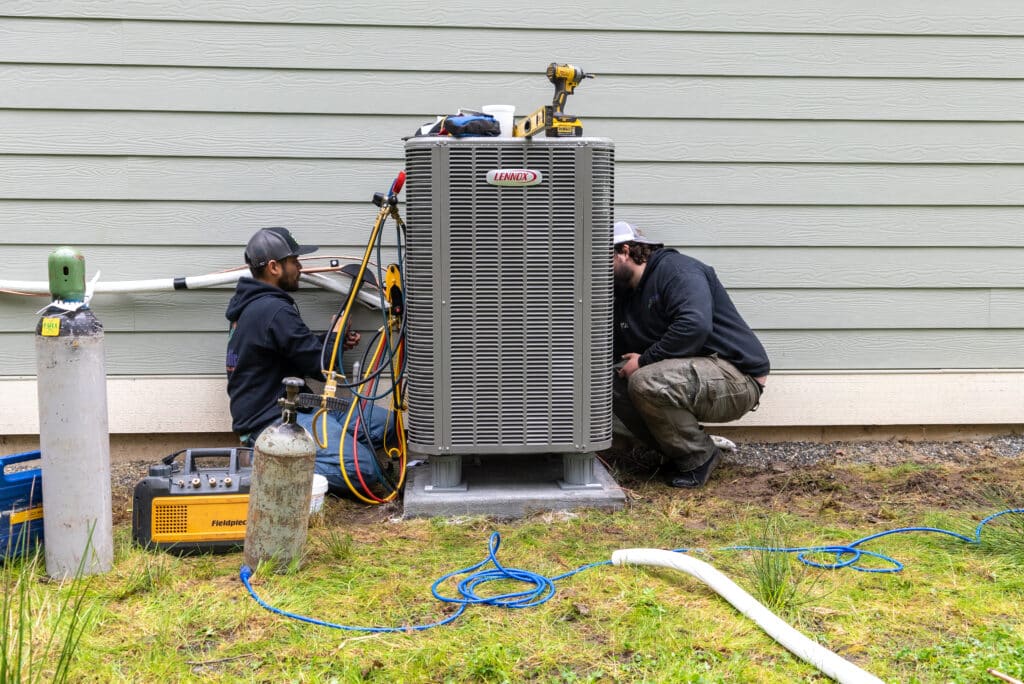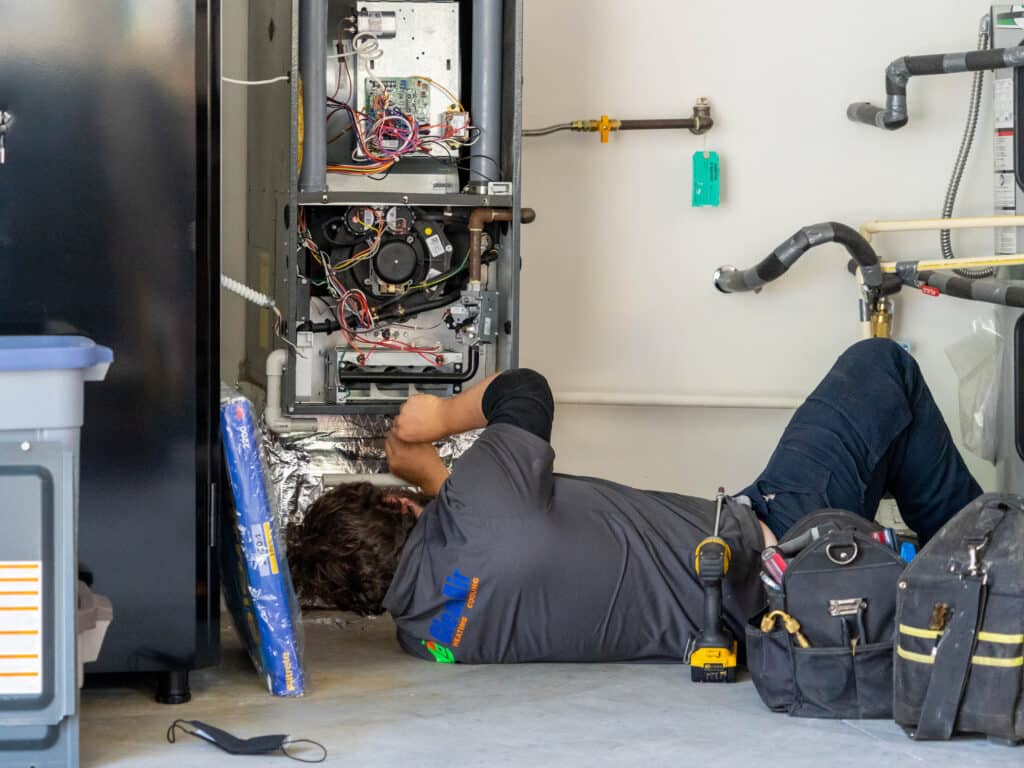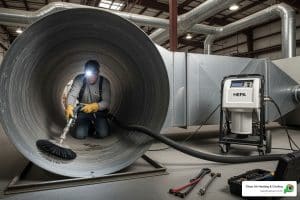The Importance of Regular HVAC Cleaning and Inspection
HVAC cleaning and inspection is crucial for every homeowner. Without proper maintenance, your HVAC system can suffer from reduced energy efficiency, poor air quality, and an increased risk of costly repairs. Here’s a quick rundown of why you should prioritize regular HVAC cleaning and inspection:
- Improved Air Quality: Clean systems mean fewer pollutants and allergens circulating in your home.
- Energy Efficiency: A well-maintained HVAC system uses less energy, leading to lower utility bills.
- Extended System Lifespan: Routine checks prevent breakdowns and expensive repairs.
- Healthier Living Environment: Reduces the likelihood of mold and bacteria growth in your ductwork.
My name is Colin Matei, and as the Owner and President of Clean Air Heating & Cooling, I bring years of expertise in ensuring homes like yours remain comfortable and energy-efficient through meticulous HVAC cleaning and inspection.

Benefits of Regular HVAC Cleaning and Inspection
Regular HVAC cleaning and inspection offers several key benefits that can make a big difference in your home. Let’s break down why these routine checks are so essential:
Energy Savings
A clean HVAC system runs more efficiently. When dust and dirt build up in your system, it has to work harder to heat or cool your home. This extra effort means more energy consumption and higher utility bills. According to the U.S. Department of Energy, 25 to 40 percent of the energy used for heating and cooling a home is wasted due to inefficiencies like dirty components and poor insulation.

Improved Air Quality
Your HVAC system circulates air throughout your home. If it’s dirty, it can spread dust, pollen, and other allergens. Regular cleaning removes these particles, leading to better indoor air quality. This is especially important for people with allergies or respiratory issues. Simple tasks like changing your air filters every two or three months can make a huge difference.
Extended System Lifespan
Regular maintenance can add years to the life of your HVAC system. Most systems last about 10-15 years, but with proper care, they can last even longer. By catching and fixing small issues early on, you prevent them from turning into major problems that could lead to expensive repairs or even system replacement.
Reduced Repair Costs
Frequent inspections and cleanings help identify potential issues before they become serious. Something as simple as a clogged filter or a dusty coil can cause your system to break down if left unchecked. Regular maintenance can help you avoid these costly repairs. The Clean Air Heating & Cooling team has found that routine inspections often catch minor issues that, if left untreated, could lead to major system failures.

By understanding these benefits, you can see why regular HVAC cleaning and inspection is a smart investment for any homeowner. Up next, we’ll discuss the signs that indicate your HVAC system needs cleaning and inspection.
Signs Your HVAC System Needs Cleaning and Inspection
Keeping an eye on your HVAC system can save you from bigger problems down the road. Here are some clear signs that it’s time for an HVAC cleaning and inspection:
Clogged Vents
If you notice dust and debris piling up around your vents, it’s a sign that your HVAC system might be clogged. Blocked vents not only reduce airflow but also force your system to work harder, which can lead to higher energy bills and potential damage.
Unpleasant Odors
Strange smells coming from your HVAC vents are never a good sign. These odors could indicate mold or mildew growth within the system, which can pose serious health risks. As mentioned in our research, mold begins with a moisture problem, often found in the cooling system’s evaporator coils or leaky return ducts.
Mold Presence
Mold growth is a serious issue that needs immediate attention. If you see visible mold or consistently smell a musty odor, it’s crucial to address the moisture source first. Cleaning the ducts alone won’t solve the problem. Instead, consider having a professional inspect your system for leaks and moisture issues.
Poor Airflow
Weak or inconsistent airflow from your vents can indicate several problems, such as clogged filters, blocked ducts, or even issues with the blower motor. Poor airflow not only makes your home less comfortable but also reduces the efficiency of your HVAC system, leading to higher energy consumption.
Increased Energy Bills
A sudden spike in your energy bills can be a red flag. If your system is working harder to maintain the same temperature, it’s likely due to inefficiencies caused by dirt and debris buildup. Regular cleaning and inspections can help keep your system running efficiently, saving you money in the long run.
By staying vigilant for these signs, you can ensure your HVAC system remains in top condition. Up next, we’ll explore how often you should clean and inspect your HVAC system to keep it running smoothly.
How Often Should You Clean and Inspect Your HVAC System?
Regular HVAC cleaning and inspection are essential for keeping your system efficient and your home’s air quality high. But how often should you schedule these services? Let’s break it down.
NADCA Recommendations
The National Air Duct Cleaners Association (NADCA) suggests cleaning your air ducts every three to five years. However, this frequency can vary based on several factors, such as the age of your HVAC system, your home’s air quality, and specific conditions like pets or recent renovations.
Seasonal Maintenance
Your HVAC system works differently in summer and winter, requiring distinct maintenance tasks for each season. Before summer hits, schedule a service visit to ensure your air conditioning system is ready for the heat. Similarly, before winter, have your heating system inspected. Regular maintenance can catch small issues before they become big problems, ensuring your system runs smoothly year-round.
Typical Seasonal Maintenance Tasks:
– Summer: Check refrigerant levels, clean evaporator and condenser coils, and inspect the thermostat.
– Winter: Examine the ignition burner, inspect the heat exchanger, and check for gas leaks.
Specific Conditions Requiring More Frequent Cleaning
Certain conditions may necessitate more frequent HVAC cleaning and inspections:
- Allergies or Respiratory Issues: If anyone in your household suffers from allergies or asthma, consider more frequent cleanings to reduce allergens like dust and mold.
- Pets: Pet hair and dander can quickly clog filters and ducts, requiring more regular cleaning.
- Renovations: Home renovations can introduce a lot of dust and debris into your ductwork, so it’s a good idea to clean your HVAC system afterward.
- High Humidity: Moisture can lead to mold growth, which is why homes in humid climates may need more frequent inspections and cleanings.
By following these guidelines, you can ensure your HVAC system remains efficient and your indoor air quality stays high. Up next, we’ll dive into the process of HVAC cleaning and inspection to give you a clearer picture of what to expect.
The HVAC Cleaning and Inspection Process
Understanding the HVAC cleaning and inspection process can help you keep your system in top shape. Let’s break down the steps involved:
Visual Inspection
A thorough visual inspection is the first step. This involves checking key parts of your HVAC system to identify any visible issues.
Checklist for Visual Inspection:
– Cooling Coil: Ensure both sides are visibly clean. Shine a flashlight through it; light should pass through if it’s clean.
– Blower Blades: Check for oil and debris.
– Air Vents: Ensure registers, grilles, and diffusers are firmly attached and visibly clean.
Cleaning Components
Once the visual inspection is complete, the next step is to clean the system’s components. This includes:
- Coils: Clean the evaporator and condenser coils to improve efficiency.
- Blower: Remove dust and debris from blower blades.
- Drain Pan: Ensure the coil drain pan is clean and draining properly.
- Filters: Replace or clean filters to maintain air quality and system efficiency.
Checking for Leaks
Air leaks can reduce system efficiency and increase energy costs. Here’s how to check for leaks:
- Main Unit: Feel around air duct connections for leaks. Wetting your hand can help detect airflow.
- Branch Ducts: Inspect visible ducts in places like the basement or attic. Look for damage or wet spots in the insulation.
- Seal Leaks: Use HVAC aluminum foil tape or mastic sealant to patch up any leaks. Clean the area before applying the sealant for best results.
Professional vs. DIY
While some tasks can be done yourself, others are best left to professionals.
DIY Tasks:
– Basic Visual Inspections: Check for visible dust, debris, and leaks.
– Filter Replacement: Change filters every 1-3 months.
– Cleaning Vents: Regularly clean grilles and diffusers.
Professional Tasks:
– Deep Cleaning: Professionals use specialized equipment like HEPA-filtered vacuums to remove dirt from deep inside the system.
– Compressed Air Flush: This technique blows compressed air through the system to dislodge and vacuum out contaminants.
– Advanced Inspections: Professionals can identify and address issues like mold growth, vermin infestations, and complex leaks.
By understanding the HVAC cleaning and inspection process, you can make informed decisions about maintaining your system. This not only improves efficiency but also improves indoor air quality.
Next, we’ll discuss some common issues found during HVAC inspections and how to address them.
Common Issues Found During HVAC Inspections
Even with regular maintenance, HVAC systems can develop problems. Here are some common issues you might encounter during an HVAC cleaning and inspection:
Dust and Debris
Dust and debris can accumulate in your HVAC system, affecting its performance and air quality. This is especially true if the ducts were not sealed during renovation projects. Dust can cling to the duct surfaces and may not necessarily enter your living space, but it can still reduce system efficiency.
How to Address It:
– Regular Cleaning: Use a HEPA-filtered vacuum to clean accessible parts.
– Filter Replacement: Change your filters every 1-3 months to keep dust levels low.
– Professional Cleaning: For deep cleaning, hire a professional who can use specialized equipment.
Mold Growth
Mold is a serious issue that can compromise your indoor air quality and health. Mold growth often starts with a moisture problem, which can be due to leaky return ducts or issues with the cooling system’s evaporator coils.
Signs of Mold:
– Musty Smell: Consistent musty odor from supply vents.
– Visible Growth: Mold spots on ducts or other components.
How to Address It:
– Moisture Control: Fix any leaks and ensure proper drainage to prevent mold.
– Professional Inspection: Have a professional check for mold and clean the system thoroughly.
– Avoid DIY Mold Testing: Experts suggest focusing on moisture control rather than testing for mold types.
Vermin Infestation
Vermin infestations like rodents or insects in your HVAC system can cause significant damage and health risks. These pests can chew through insulation, leave droppings, and even die inside the ducts, causing foul odors and contamination.
How to Address It:
– Regular Inspections: Check your ducts and vents for signs of vermin.
– Seal Entry Points: Ensure that all entry points are sealed to prevent pests from getting in.
– Professional Extermination: If you find signs of infestation, contact a pest control professional.
Air Leaks
Air leaks in your HVAC system can lead to reduced efficiency and higher energy bills. Leaks often occur at duct connections and seams, allowing conditioned air to escape and unconditioned air to enter.
How to Detect Leaks:
– Feel for Airflow: Wet your hand slightly and feel around duct connections.
– Incense Stick Test: Use an incense stick to detect airflow changes around seams.
How to Address It:
– Seal Leaks: Use HVAC aluminum foil tape or mastic sealant to seal any detected leaks. Clean the area before applying the sealant for the best results.
– Professional Inspection: Have a professional check for and seal any leaks you might have missed.
By being aware of these common issues, you can take proactive steps to maintain your HVAC system. Regular HVAC cleaning and inspection not only improves system performance but also improves your home’s air quality and energy efficiency.
Next, we’ll answer some frequently asked questions about HVAC cleaning and inspection.
Frequently Asked Questions about HVAC Cleaning and Inspection
How Often Should a HVAC Unit Be Cleaned?
The National Air Duct Cleaners Association (NADCA) recommends cleaning your HVAC system every three to five years. However, this can vary based on specific conditions in your home. If you have pets, allergies, or live in an area with high pollution, you might need more frequent cleanings. Regular maintenance ensures your system runs efficiently and your indoor air quality remains high.
Does Cleaning Air Ducts Really Make a Difference?
Yes, cleaning air ducts can make a significant difference in several ways:
- Health Impact: Clean ducts reduce the presence of allergens like pollen, pet dander, and mold spores. This is especially beneficial for those with allergies or asthma.
- Efficiency: Dust and debris buildup can obstruct airflow, making your HVAC system work harder. Clean ducts help your system run more efficiently, potentially lowering your energy bills.
- Air Quality: Over time, ducts can accumulate dust, mold, and other contaminants. Cleaning them improves the overall air quality in your home, making it a healthier environment for you and your family.
How Do I Know If My HVAC Needs to Be Cleaned?
Here are some signs that your HVAC system may need cleaning:
- Clogged Vents: If you notice dust and debris around your vents, it might be time for a cleaning.
- Unpleasant Odors: Musty or foul smells coming from your ducts can indicate mold or vermin infestation.
- Poor Airflow: Reduced airflow from your vents can signal blockages or buildup in your ducts.
- Increased Energy Bills: If your energy bills are higher than usual, your HVAC system might be working harder due to dirty ducts.
For a professional evaluation, consider scheduling an inspection with a trusted HVAC service provider like Clean Air Heating & Cooling. They can provide a thorough assessment and recommend the best course of action to keep your system running smoothly.
Conclusion
Regular HVAC cleaning and inspection offer numerous benefits for your home. They help save energy, improve air quality, extend the lifespan of your system, and reduce repair costs. By keeping your system clean, you ensure it operates efficiently and provides a healthier environment for your family.
At Clean Air Heating & Cooling, we take pride in delivering top-notch HVAC services. Our experienced technicians follow industry standards to ensure your system is thoroughly cleaned and inspected. We use advanced equipment to remove dust, debris, and contaminants from your ducts, leaving your home with cleaner air and a more efficient HVAC system.
Customer satisfaction is our priority. We understand the importance of a well-maintained HVAC system, and our team is dedicated to providing excellent service every time. Don’t just take our word for it—our customers consistently report improved air quality and lower energy bills after our visits.
Ready to breathe cleaner air and enjoy a more efficient HVAC system? Schedule your inspection with us today.
Your comfort is our mission. Let’s keep your home safe, healthy, and comfortable all year round.





